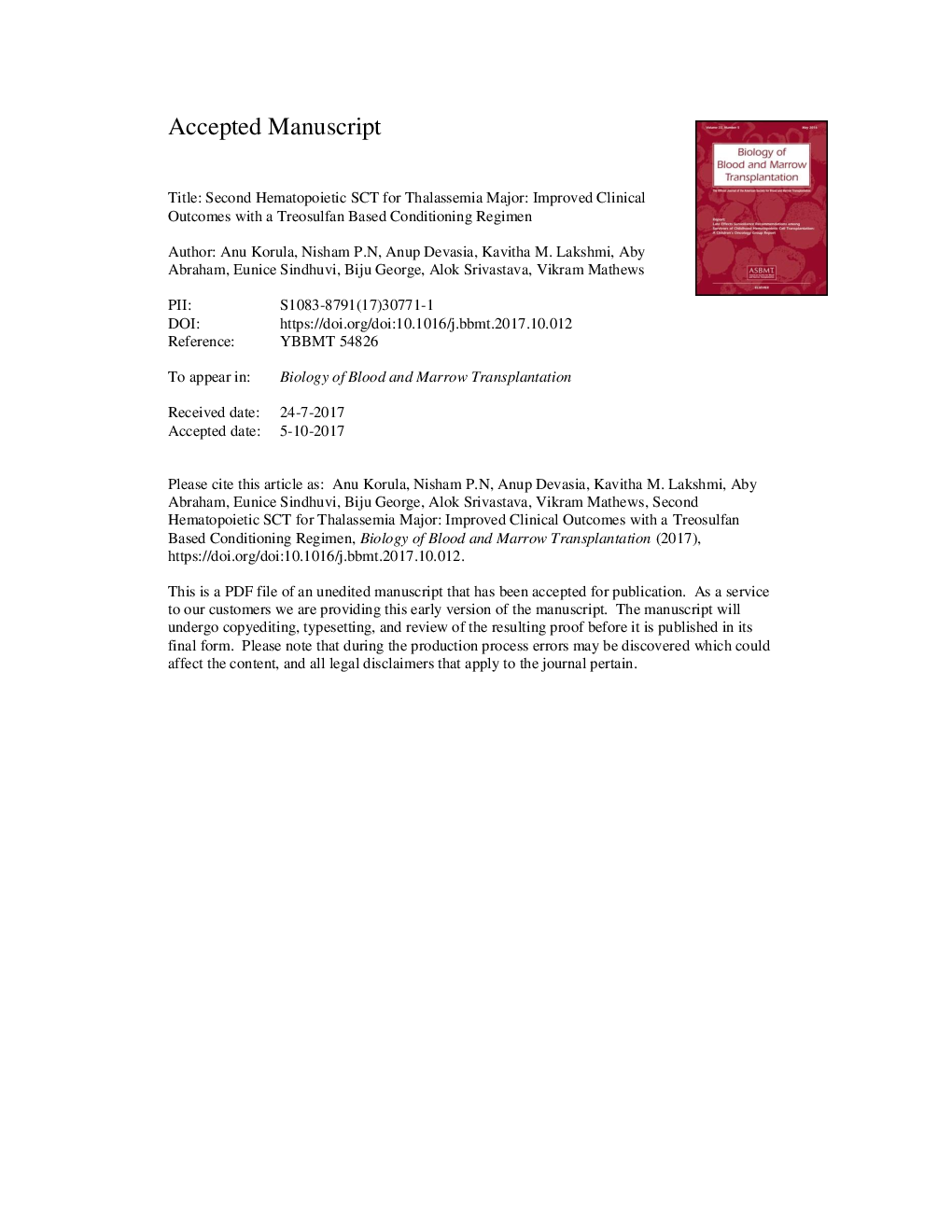| کد مقاله | کد نشریه | سال انتشار | مقاله انگلیسی | نسخه تمام متن |
|---|---|---|---|---|
| 8430547 | 1546233 | 2018 | 20 صفحه PDF | دانلود رایگان |
عنوان انگلیسی مقاله ISI
Second Hematopoietic Stem Cell Transplant for Thalassemia Major: Improved Clinical Outcomes with a Treosulfan-Based Conditioning Regimen
ترجمه فارسی عنوان
دوم پیوند سلولهای بنیادی برای تالاسمی ماژور: نتایج بالینی بهبود یافته با یک سیستم تهویه مطبوع مبتنی بر ترئوسولفان
دانلود مقاله + سفارش ترجمه
دانلود مقاله ISI انگلیسی
رایگان برای ایرانیان
کلمات کلیدی
رد انتقام، ²-تالاسمی ماژور، پیوند دوم، ترئوسولفان،
موضوعات مرتبط
علوم زیستی و بیوفناوری
بیوشیمی، ژنتیک و زیست شناسی مولکولی
تحقیقات سرطان
چکیده انگلیسی
Graft rejection (GR) after allogeneic stem cell transplantation (allo-SCT) occurs in 10% to 20% of patients with β-thalassemia major (TM). There are limited data on the clinical profile and long-term outcome of patients who have had a GR. We undertook a retrospective analysis of patients who had a graft failure after allo-SCT for TM at our center. From October 1991 to June 2016, 55 of 506 patients (11%) transplanted for TM had a graft failure. An additional 7 patients with graft failure after allo-SCT done at other centers were referred to us for a second transplant. The median age was 8 years (range, 1 to 19), and there were 38 males (61.2%). Thirty-two patients (52.4%) were primary graft failures (15 with aplasia and 17 with autologous recovery) and 30 (47.6%) were secondary graft failures (5 with aplasia and 25 with autologous recovery). On conventional risk stratification 40 patients (64.5%) were class III. Seventeen patients (53.12%) with primary graft failure and 16 (53.3%) with secondary graft failure did not receive a second transplant. Twenty-nine patients (46%) with GR underwent a second allo-SCT. With the exception of 1 patient (first allo-SCT with an unrelated cord blood product), the donor for the second transplant was the same as the first transplant. Conditioning regimen for the second SCT was busulfan-based myeloablative (MAC) in 7 patients (24%), treosulfan-based MAC in 12 patients (41.3%), and the remaining received non-MAC regimens in view of pancytopenia and perceived inability to tolerate MAC. None of the patients conditioned with a treosulfan-based regimen had a GR, although 1 patient died with complications secondary to chronic graft-versus-host disease. Of the remaining 17 patients, 10 died after the second GR and 3 of regimen-related toxicity. Four are alive, of which 1 has recurrent TM and the rest are well and transfusion independent at 55, 80, and 204 months, respectively, from second transplant (all busulfan-based MAC). On a univariate analysis a nontreosulfan-based conditioning regimen and time from GR to second transplant of <1 year was significantly associated with an adverse impact. However, on a multivariate analysis only a nontreosulfan-based regimen was associated with a significant adverse impact on event-free survival (HR,â11.5; 95% CI, 1.13 to 116.4; Pâ=â.039). In conclusion, there has been a significant improvement in clinical outcomes in our experience with the use of a treosulfan-based reduced-toxicity MAC regimen for second allo-SCT for TM. It would be reasonable, where feasible, to defer the second transplant by a year after the first GR.
ناشر
Database: Elsevier - ScienceDirect (ساینس دایرکت)
Journal: Biology of Blood and Marrow Transplantation - Volume 24, Issue 1, January 2018, Pages 103-108
Journal: Biology of Blood and Marrow Transplantation - Volume 24, Issue 1, January 2018, Pages 103-108
نویسندگان
Anu Korula, Nisham PN, Anup Devasia, Kavitha M. Lakshmi, Aby Abraham, Eunice Sindhuvi, Biju George, Alok Srivastava, Vikram Mathews,
